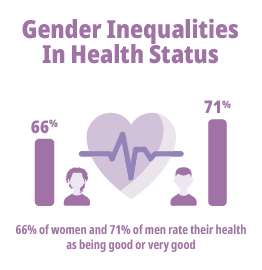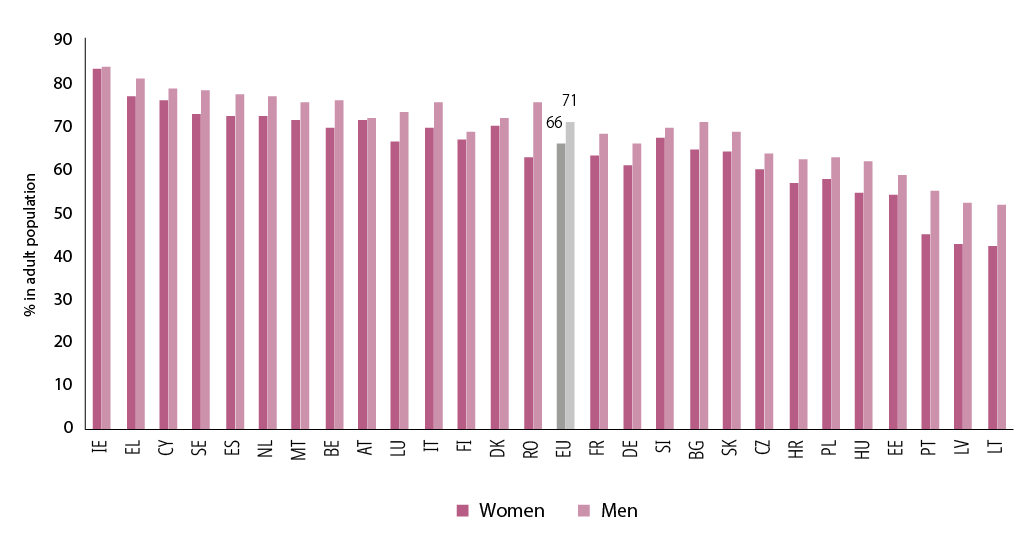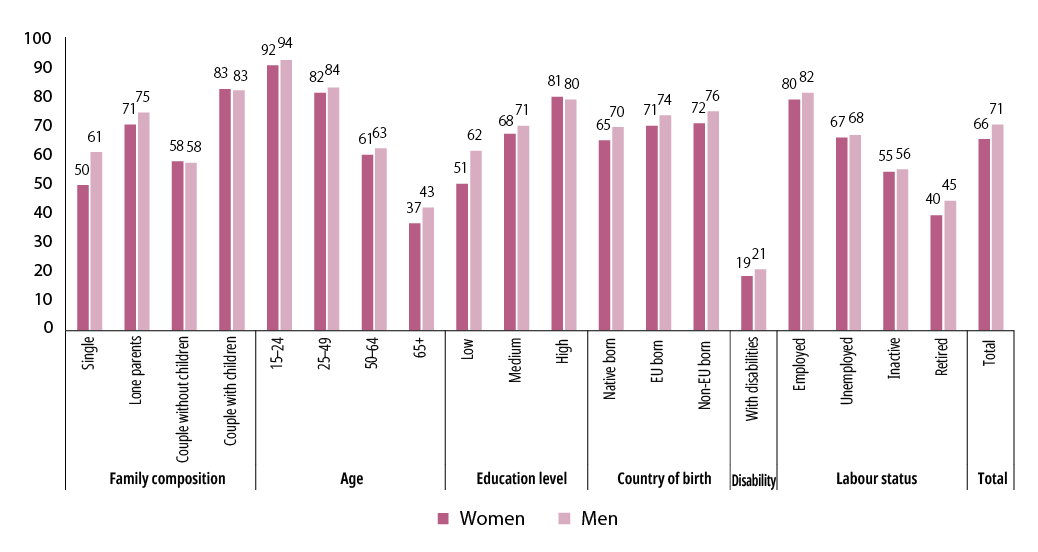Men are more likely to perceive their health as good

Self-reported health (self-rated health, self-assessed health or self-perceived health) is a person’s subjective evaluation of their current health status (Lorem et al., 2017). Overall, women tend to report worse health than men (Nesson and Robinson, 2019), except on hearing problems and cardiovascular diseases (Caroli and Weber-Baghdiguian, 2016). In a 2002–2004 study of 59 countries globally, women reported significantly poorer health than men on all self-reported health indicators at all ages – although differences were smaller from 60 years onwards – and in all regions, with the smallest disparities in high-income European countries (Boerma et al., 2016).
In the EU-27, 66 % of women and 71 % of men perceive their health to be good or very good (Figure 24). Gender gaps in self-reported health are greater in Portugal, Latvia and Lithuania (10 p.p.), and in Romania and Bulgaria (9 p.p.). Only in Ireland do women and men equally perceive being in good health. The share of women considering themselves in good health is lowest in Hungary, Estonia, Portugal, Latvia and Lithuania.
Among adolescents, gender gaps in self-reported health are slightly more pronounced than for the adult population, with 30 % of girls and 39 % of boys rating their health as excellent[1].
Figure 24. Women and men perceiving their health as good or very good by EU Member State (%, 16+ years, EU, 2019)
Source: Eurostat, https://ec.europa.eu/eurostat/web/products-datasets/-/hlth_silc_01.
Age, disability and education are important markers in shaping individual health status, with self-reported health levels the lowest for women with disabilities, women over 65 years and retired women (Figure 25).
Figure 25. Women and men perceiving their health as good or very good by sex, family composition, age, education, country of birth, disability and labour status (%, 16+ years, EU, 2019)
NB: EU-born and non-EU born are based on 21 countries (DE, EE, LV, MT, RO and SI are excluded).
Source: Authors’ calculation with microdata, EU-SILC, 2019 (IE, IT, 2018).
Table 19 in Annex 4 presents the share of people across population groups reporting their health as being good or very good from various data sources. It signalises how gender intersects with income levels, living environments (rural, suburban or urban), sexual orientation and migration status to determine a person’s likelihood of having good health.
According to WHO, many conditions and factors impacting people’s health are not under individual control. These include income, social status, education, physical environment, social support networks, genetics, health services and gender.
Research has highlighted gender-specific effects of three major SDH – education, employment and income levels. Education has long been known to be a crucial life resource for maintaining good health. Research in nine EU countries shows that higher levels of education have positive effects on the health of women and men (Uccheddu et al., 2019), particularly in countries promoting more women’s employment. Similarly, an analysis based on EU-SILC data indicates both that the probability of poor self-perceived health generally is higher among women than among men and that the biggest gender differences in self-perceived health are among individuals with relatively low levels of education in countries with the greatest gender employment gaps, that is in southern and eastern European countries (Gumà et al., 2019).
Employment status influences people’s health through income, social status and its impact on distress (Marmot et al., 2012).Employment and higher quality of work are linked to bette r health at individual level (Barnay, 2016; Henseke, 2018). Although working has a significant positive impact on the health of women and men, its effects are stronger for men (Hosseinpoor et al., 2012). In the EU, working women and men are more likely than those not in paid work, the unemployed or retirees to rate their health as good or very good (Figure 25).
Lack of paid work is likely to affect women’s health disproportionately. For instance, Boerma et al. (2016) found that greater gender gaps in employment and education lead to greater gender gaps in health assessment, to women’s detriment. This is particularly the case in Greece, Spain, Cyprus and Portugal, where women’s labour market participation is low (Palència et al., 2014) . Therefore, being in employment may result in lower health gains for women than for men, but being employed still leads to better health outcomes than being unemployed. Gender inequalities in employment and working conditions are also connected to inequalities in health. Precarious employment is considered an SDH (Benach et al., 2014; Siegrist et al., 2016). For example, a review of 27 studies found that temporary work explained between 11 % and 23 % of the variation in poor mental health (Vives Vergara, 2010). Less is known about how gender inequalities in employment and occupational position are related to health and health inequalities. An umbrella review of macroeconomic determinants of health shows that job promotion and improved working conditions can help enhance health and reduce gender-based health inequalities (Naik et al., 2019).
Income is closely linked to individual health – higher income supports good and improved health, while better health enables higher income (Deaton, 2002; Smith, 1999). Income could be causally related to health through a direct effect on the material conditions necessary for biological survival, and indirectly through social participation and ability to control life circumstances that condition health and health risks (Lynch et al., 2004; 2002). Depending on the healthcare system, level of income determines whether healthcare is affordable and accessible because it affects an individual’s ability to pay for medical services out of their own pocket (OECD/European Union, 2018). The effect of income on health varies according to gender. A quantitative meta-analysis (Furnée et al., 2011) found significant income-related variation in self-reported poor health between women and men in different countries, even if income or standards of living were comparable.
The extent to which income impacts health status across the EU depends on country-specific contexts. Factors such as pension and wage policies play an important role (Paul Leigh et al., 2019). They are particularly relevant to the health and well-being of older people, especially women, whose income in old age reflects limited economic independence and the cumulative effect of gender inequalities over a lifetime[2] (EIGE, 2015, 2016, 2020e, 2020g).

